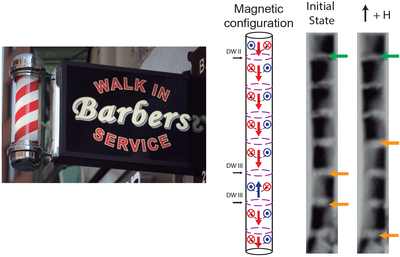
Figure. Left: Barber pole illustrating the helical lines that the magnetization describes at the surface of the wires. Right: Schematics of the configuration of the magnetization of the initial state of the nanowire together with the magnetic images before and after the application of magnetic field pulses. In the initial state, the two domain walls signaled with orange arrows separate domains with the same chirality. Note that the head-to-head or tail-to-tail domains have the same chirality in spite of having opposite signs of surface magnetization. The green arrow separates two domains of different chirality since while having the same axial orientation, the surface helicity is opposite. Magnetic field pulses of 120 mT move the walls separating domains with the same chirality but not the green wall separating opposite chirality.
Cerdanyola del Vallès, 5 November 2020. Nanomagnetism is nowadays expanding into three dimensions, triggered by the discovery of new magnetic phenomena and their potential use in applications. This shift towards 3D structures should be accompanied by strategies and methodologies to map the tridimensional spin textures associated.
A new study fruit of a collaboration of researchers from two beamlines at ALBA Synchrotron (CIRCE and MISTRAL), with the participation of the Universidad Complutense de Madrid, IMDEA Nanociencia and the Universidad de Salamanca shows that cylindrical nanowires have at the center a magnetization aligned with the axis of the wire and at the surface a magnetization that describes helical lines as the barber poles. The helicity provides chirality to the magnetic configuration since it can be right or left-handed. Researchers found out that two adjacent magnetic domains having opposite chirality are more difficult to move than two adjacent domains with the same chirality. This result evidences the role of the chirality on the dynamics of the domain walls that might be used as a practical variable for magnetic data storage.
The control of the movement of magnetic domain walls (DW) along nanostructures by means of magnetic fields or electric currents is a key aspect in the design of novel devices for magnetic data storage. The use of cylindrical nanowires (NWs) brings the emergence of novel DW structures directly linked to the cylindrical geometries, which introduces additional degrees of freedom, producing magnetic three-dimensional structures and enabling the appearance of new physics to exploit. These cylindrical nanowires can also be connected in 3D structures, enlarging the possibilities for the control of magnetic properties. Moreover, the particular spin texture observed in the cylindrical nanowires that are presented in this work enables the movement of DWs without speed limitation (the so-called Walker breakdown) making NWs excellent candidates for their integration in devices based on domain wall movement (new memories, magnetic logic, etc.).
In a previous study using PEEM (Photoemission Electron Microscopy) at the CIRCE beamline of ALBA, they were able to infer that these nanowires had an axial magnetization in the core with a magnetization at the surface exhibiting a circular pattern. However, they could not determine the sense of the axial magnetization nor the helicity of the surface magnetization. At the MISTRAL beamline, measurements of the magnetic dichroic X-ray absorption at different angles allowed to identify the helicity of the surface magnetization and its chirality and also the sense of the axial magnetization.
One light for different techniques
The nanowires under study were grown by electrodeposition inside of the porous of a nanotemplate. Afterwards, they were released from the membrane and deposited in an X-ray-transparent membrane. To study the magnetic configuration of the nanowires, they used XMCD-PEEM (X-ray Magnetic Circular Dichroism Photoemission Electron Microscopy) technique at CIRCE beamline and XMCD-TXM (X-ray Magnetic Circular Dichroism Transmission X-ray Microscopy) at MISTRAL beamline. Using TXM, researchers acquired images at iron (Fe) L3-edge with opposite photon helicity at 0 degrees and 25 degrees and subtracted them pixel by pixel. This procedure allowed determining both the axial magnetization at the core and the helical magnetization at the surfaces of the wires. After the determination of the magnetic configuration of the wires, axial magnetic fields of increasing intensities were applied to determine how the magnetic structure of the wires affects the domain wall motion. Moreover, for a better understanding of the behaviour of the wires, scientists performed micromagnetic simulations and compared the experimental and simulated results.
Reference: S. Ruiz-Gomez, C. Fernández-González, E. Martínez, V. J. Raposo, A. Sorrentino, M. Foerster, L. Aballe, A. Mascaraque, S. Ferrer and L. Perez. Helical Surface magnetization in nanowires: the role of chirality. Nanoscale, 2020. DOI: 10.1039/D0NR05424K.




